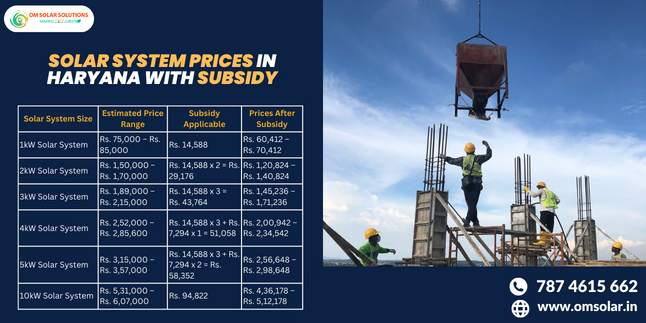In today’s ever-changing energy market, solar power is a global favorite. It is appealing due to its sustainability, environmental friendliness, and long-term cost-effectiveness. Solar panels generate electricity by converting the energy of the sun. However, the cost of solar panels is a big hurdle to public acceptability, which is why the government is providing a solar subsidy in Haryana.
Haryana, noted for its environmentally friendly energy, has numerous solar power options. Prices for solar panels in this region vary depending on the panel type, brand, and dealer. People can match their demands and budgets thanks to the range of possibilities ranging from Rs. 30,000 to Rs. 2 lakhs.
Also Read: Know Everything About Haryana Solar System Subsidy Scheme 2022
Polycrystalline solar panels are the most common in Haryana. These panels are less expensive than monocrystalline panels, however they are less efficient. Understanding the cost differences between brands and vendors is critical as consumers navigate the many possibilities. This blog delves into the subsidy on solar panels in Haryana.
Haryana Solar Subsidy Scheme 2023
The Haryana Department of Renewable Energy has just launched a transformative project known as the Solar Rooftop Power Plant to save resources for future generations. This effort brings Solar System Plants to the state’s residential, institutional, social, private, commercial, and industrial sectors.
While the advantages of solar energy are well known, the perception of high costs has hampered its adoption in the home and commercial sectors. Recognizing this difficulty, the Haryana government has taken proactive measures by instituting a 30% subsidy under the Haryana Solar Subsidy Scheme 2023 on the benchmark cost for solar installations in various sectors.
The fundamental purpose of this solar subsidy program is to encourage the use of environmentally friendly alternatives that are not only sustainable but also cost-effective, delivering savings of up to 90% compared to DHBVN (Dakshin Haryana Bijli Vitran Nigam) conventional power. Solar energy utilization can cut the average cost from Rs. 7 per unit to an economical Rs. 2 per unit for people accustomed to monthly bills ranging from Rs. 2000-3000.
Solar System Prices in Haryana with Subsidy
The updated subsidy structure, implemented under a streamlined scheme, provides a fixed subsidy on solar panels in Haryana and throughout India for solar energy plants installed by residential consumers. Central Financial Assistance (CFA) is now available for residential properties and housing societies investing in solar panel capacities ranging from 1 kW to 500 kW systems. The subsidized prices for various system capacities including 5kw solar system price in Haryana with subsidy, are outlined below:

| Solar System Size | Estimated Price Range | Subsidy Applicable | Prices After Subsidy |
| 1kW Solar System | Rs. 75,000 – Rs. 85,000 | Rs. 14,588 | Rs. 60,412 – Rs. 70,412 |
| 2kW Solar System | Rs. 1,50,000 – Rs. 1,70,000 | Rs. 14,588 x 2 = Rs. 29,176 | Rs. 1,20,824 – Rs. 1,40,824 |
| 3kW Solar System | Rs. 1,89,000 – Rs. 2,15,000 | Rs. 14,588 x 3 = Rs. 43,764 | Rs. 1,45,236 – Rs. 1,71,236 |
| 4kW Solar System | Rs. 2,52,000 – Rs. 2,85,600 | Rs. 14,588 x 3 + Rs. 7,294 x 1 = 51,058 | Rs. 2,00,942 – Rs. 2,34,542 |
| 5kW Solar System | Rs. 3,15,000 – Rs. 3,57,000 | Rs. 14,588 x 3 + Rs. 7,294 x 2 = Rs. 58,352 | Rs. 2,56,648 – Rs. 2,98,648 |
| 10kW Solar System | Rs. 5,31,000 – Rs. 6,07,000 | Rs. 94,822 | Rs. 4,36,178 – Rs. 5,12,178 |
Call to action;- (Get a free consultation on “subsidy on solar panels in Haryana” right now. Call Us-1234567890)
Applying for a subsidy in Haryana: A Step-by-Step Guide.
Go to the National Portal for Rooftop Solar to get started with your home solar energy system through the government’s solar subsidy program. The application method for a solar panel subsidy Haryana online form is simple. Follow these basic steps to finish:
First, you will need to complete the registration process.
Before you can begin your journey as a solar energy consumer, it is important to first register on the National Portal for Rooftop Solar. Please choose your local DISCOM company and provide your Electricity connection number / Consumer number along with the other details requested during the process.
Next, proceed with the application process for rooftop solar installation.
You can now access your account and begin the subsidy process by submitting your application online. Please provide additional information such as the address, name on the electricity bill, the capacity of the proposed RTS plant, and any details regarding an existing solar system, if applicable. Additionally, please include a copy of your most recent electricity bill.
Step 3 – Approval of Technical Feasibility/TFR
Your online application has been forwarded to your state DISCOM for review and approval regarding its technical feasibility. It is important to ensure that your application is free from any inaccuracies, as they may lead to the dismissal of your application. It is highly recommended that applicants wait to begin the solar panel installation until they have obtained the technical feasibility (TFR) approval.
Vendor Selection and Plant Installation
Once you have obtained a positive TFR status, you can proceed with selecting a solar company to carry out the installation work. The solar subsidy guidelines issued by the MNRE require all applicants to hire vendors from the ALMM list of impaneled vendors. These vendors have received comprehensive training to ensure that all installations are carried out strictly with the minimum technical specifications and standards mandated by the subsidy guidelines. Furthermore, it is important to note that the solar panel subsidy in Haryana and throughout India is exclusively applicable to grid-tied solar systems that are comprised of solar components manufactured in India.
Additionally, it is important to ensure that the ALMM declaration form is signed by your vendor at the beginning of the project. This is a model agreement recommended by MNRE to safeguard the interests of consumers.
Proceed to Step 4 and provide the necessary installation details.
After installing your solar power plant in Haryana, please ensure that all the necessary documents are uploaded onto the National Portal. Additionally, we kindly request a photograph of the applicant next to the RTS system. Following this step, government officials are set to visit your solar plant to conduct an inspection and assess the net metering provision.
Step 5 – Inspection conducted by the DISCOM
A field officer from your state DISCOM conducts a comprehensive inspection of your rooftop solar energy plant to verify that the installation adheres to the technical specifications and standards set by the MNRE. After a thorough inspection, your system will be equipped with a net meter.
Step 6 – Status of Project Commissioning
If your system meets the requirements outlined in the MNRE’s subsidy guidelines, your application will be approved by the DISCOM authority. A commission certificate is generated and can be easily accessed by the applicant through their account on the National Portal.
Step 7 – Request for Subsidy/CFA
You can easily view the approved subsidy amount on the portal. To complete the process, you will need to submit your bank details along with a copy of the canceled cheque. Once you have done this, you can proceed to raise a subsidy/CFA claim request online. The subsidy amount will be deposited directly into the applicant’s bank account within 30 days of the installation.
Also Read: Solar Panel Price In Haryana With Subsidy
Advantages of Solar Panel Subsidy in Haryana.
There are several notable advantages to taking advantage of a solar subsidy in Haryana:
- This can potentially incentivize more households to transition to solar energy systems, leading to a decrease in reliance on non-renewable energy sources for electricity production.
- Customers who choose to install the solar system under the subsidy scheme can benefit from a generous 5-year performance warranty offered by the impaneled vendor.
- Customers have the opportunity to accumulate solar credits by selling any excess energy they generate back to the grid, thanks to the net metering regulations.
Final Reflection
Finally, government measures and the transformative Haryana solar subsidy make solar power a promising sector. A 30% subsidy on benchmark costs makes the Haryana Solar Subsidy Scheme 2023 a model for a sustainable and cost-effective energy transformation. The 1 kW to 10 kW pricing structure shows how much individuals and institutions may save, making solar energy a practical and affordable option. The National Portal for Rooftop Solar simplifies registration to commissioning. Over and above financial benefits, the subsidy program promotes solar system adoption, environmental responsibility, and renewable energy use. Haryana’s solar power journey promises cleaner, greener, and cheaper energy alternatives for a sustainable future.
Contact us for additional information, we will gladly assist you.

